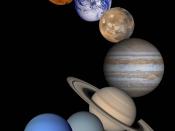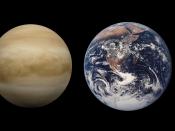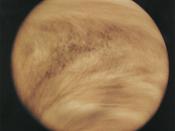"Venus: Our Sister Planet?"
Venus is known as the jewel of the sky. It was thought to be two different planets by ancient astronomers and thus referred to as the morning star and the evening star. Early astronomers also referred to Venus as Earth's sister planet. Both are considered young planets due to the low number of craters and both are similar in size, and their chemical compositions are similar. The surface of Venus has many features, which are similar to the Earth such as canyons, volcanoes, lava flows, rift valleys, mountains, craters, and plains. The comparisons basically end there.
Venus differs from the Earth in many ways. The one big difference that I noticed was the surface temperature of the planet. It reaches a surface temperature of 900ð F. This is hotter than Mercury, which is closer to the sun. This temperature is hot enough to melt lead. This higher temperature is attributed to a runaway greenhouse effect caused by the heavy atmosphere of carbon dioxide.
This would also probably account for the lack of water on the planet. The oceans, if there were ever any, were probably boiled away millions of years ago. The extremely hot temperature also attributes to the fact that no life forms have been found on Venus.
Venus makes one trip around the sun faster than it can rotate once. It takes 225 Earth days for Venus to orbit the Sun and it takes 243 days for it to rotate once. A Venusian day is longer than a Venusian year. It also rotates in the opposite direction than the Earth. The Sun would rise in the west and set in the east if observed from Venus. "In addition, the periods of Venus' rotation and of its orbit are synchronized such that it always presents...



What If?
That is an interesting point you brought up in the conclusion, what if Venus did form similar enough to earth that is could sustain life, how would life as we know it change, would we teach them things, or would they teach us thing, thats a pretty deep topic.
5 out of 5 people found this comment useful.